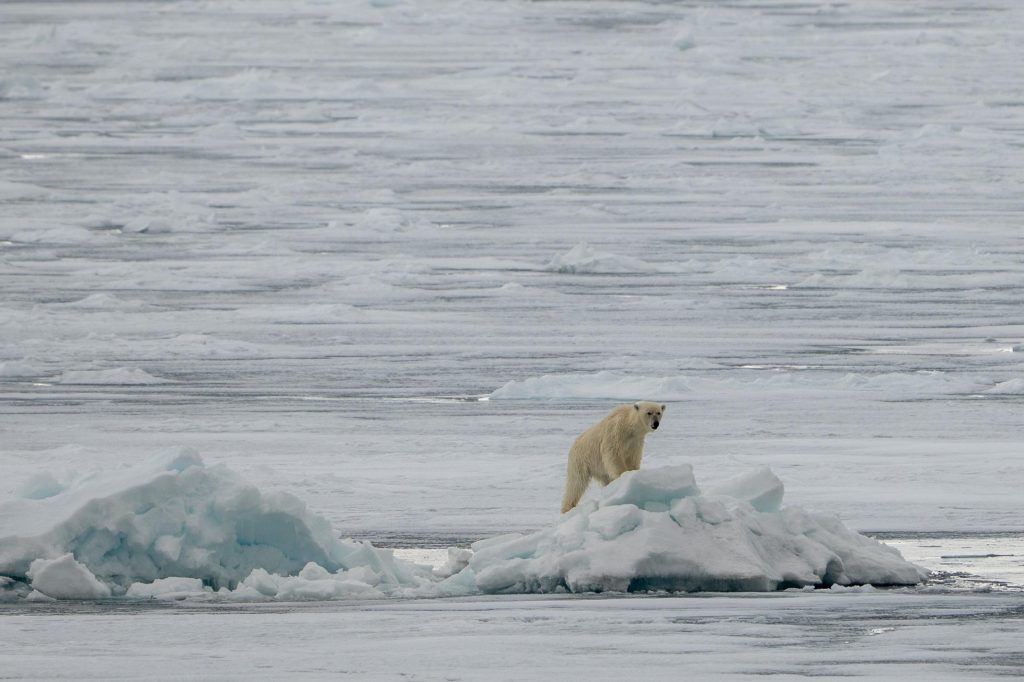Aboard Quark Expedition’s ice class ship Ocean Explorer, the expedition leader’s voice wakes guests over the PA system in the morning before breakfast. It’s day four of a high Arctic trip through Svalbard, an archipelago of islands that’s one of the northernmost land masses in the world. Svalbard is famous as an Arctic wilderness of serrated peaks, tumbling glaciers, and shifting sea ice. It’s also home to an array of Arctic wildlife, including foxes, walrus, reindeer, whales—and polar bears, which is what most travelers come here to see.
That is why leader David Wood is waking guests up . “A polar bear has been spotted off the bow,” he announces. Throughout the 138-passenger ship, travelers hustle out of bed and into gear warm enough for an early June morning up here—it’s in the low 30s F°. Some even eschew coffee in the excitement on the way up to the outer decks, from which they’ll watch the bear for as long as the ship has a good view of it.
But this season, there’s a difference in how wildlife like this is allowed to be viewed. The Norwegian government, which controls Svalbard, put new regulations in place that started in January of 2025 to protect this fragile Arctic environment, which last year saw an estimated 500 cruise ships carrying 26,000 passengers. One of those regulations is that expedition ships must keep a distance of at least 300 meters from polar bears. Between March and June, it’s 500 meters.
“Climate change is leading to more difficult conditions for polar bears on Svalbard,” Andreas Bjelland Eriksen, the Norwegian minister of climate and environment, told The Independent. “It is important for them to be able to search for food, hunt, rest, and take care of their cubs without interference from humans. Keeping a good distance will also ensure that dangerous situations do not arise and that polar bears do not get used to humans over time.”
Other new regulations include a ban on drone use, and a ban on breaking fast ice, which is ice that’s anchored to the shore or a shallow ocean bottom and doesn’t move with wind or currents, like sea ice does. Polar bears rely on fast ice as a platform for hunting seals.
There was some initial unease within the travel industry and media that these regulatory changes in Svalbard would negatively impact the guest experience. Paul Goldstein, an expedition leader and photographer with the cruise operator Secret Atlas, said that “thousands of cabins” are going unbooked on ships due to the distance rule, as “the pleasure and thrill” of a close-up encounter with Earth’s largest land-based predator “is being denied.”
But how much was the experience actually being impacted by these rules?
Polar Bear Encounters Before and After Regulations
On Ocean Explorer, guests are quietly watching a sub-adult female from the two outer decks on the bow of the ship, which the captain is keeping 500 meters away from the bear. Before the new regulations, says Annie Inglis, Marine Biology Presenter with Quark, the expedition crew would be hurrying to get guests in Zodiacs to try to get closer to a bear sighting like this.
“It was always based on a non-disturbance principle,” she says, where any sign that wildlife was changing behavior due to the presence of people or boats meant the boats backed off. Inglis did have some concerns about the new regulations because “we always want to give guests the best possible experience for seeing wildlife, to meet or exceed expectations they may have.”
But without the stress of logistics and time spent in lowering Zodiacs into the water, getting people geared up in waterproof layers, boots, and lifejackets and off the ship into the small rubber boats, Inglis says the experience is, in fact, better.
“The quality of the experiences we’ve been having this season have so far been remarkable. We’re able to observe behavior, watch for longer, and people can find a spot on deck where they can watch comfortably, and change position. We set up scopes all around.”
Deck Viewing Allows for Longer Encounters
From the height of the upper bow decks, the view of the bear is exceptional. For an hour and a half, guests watch her pace on the ice. She breaks into a run a few times. She climbs a hummock for a better view, and finds a lead of open water to take herself swimming. She stalks a seal resting on the ice, unsuccessfully.
“That’s one sign she’s a sub-adult,” Inglis says. “She’s wasting precious energy swimming, running, and rolling.”
The thing is, 500 meters doesn’t seem that far away. Guests are close enough that through binoculars, one can clearly see the blood and blubber from the bear’s last meal still staining her muzzle.
“I have heard from both Quark and Oceanwide that they are getting much higher guest satisfaction scores on their Svalbard expeditions this year in comparison with previous years,” said Kassandra Magruder, Senior Trip Planner with Adventure Life, a travel planning company that sells Arctic trips. “They feel that the new regulations in Svalbard are having no negative effects on their ability to deliver a world-class experience to their guests. From Adventure Life’s standpoint, Svalbard bookings continue to be as strong as ever and we are seeing less availability for the 2026 season than we have in past years at this same time.”
If seeing polar bears in an Arctic wilderness is on your bucket list, now is the time to plan a Svalbard trip.

